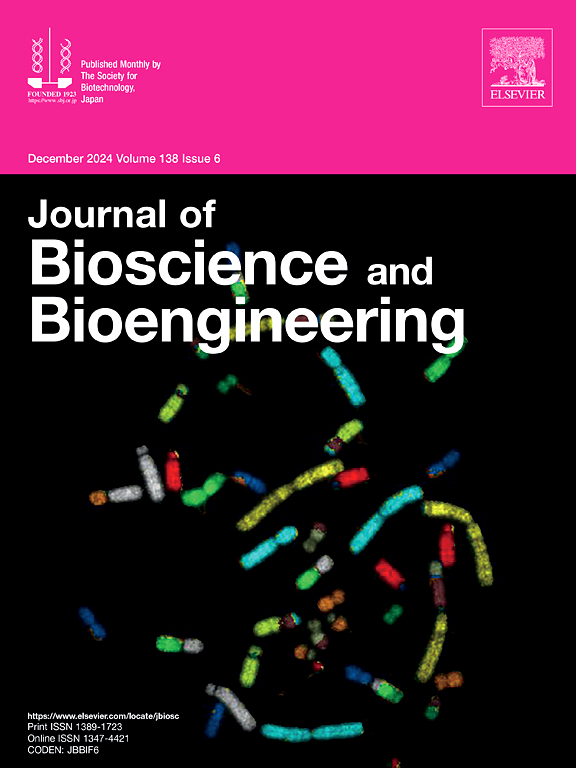Positive impact of pyrocarbon and mechanical loading on cartilage-like tissue synthesis in a scaffold-free process
IF 2.3
4区 生物学
Q3 BIOTECHNOLOGY & APPLIED MICROBIOLOGY
引用次数: 0
Abstract
Aiming to build a tissue analogue engineered cartilage from differentiated chondrocytes, we investigated the potential of a pyrocarbon (PyC)-based and scaffold-free process, under mechanical stimulation. PyC biomaterial has shown promise in arthroplasty and implant strategies, and mechanical stimulation is recognized as an improvement in regeneration strategies. The objective was to maintain the cell phenotype to produce constructs with cartilage-like matrix composition and mechanical properties. Primary murine chondrocytes were deposited in drop form between two biomaterial surfaces expanded to 500 μm and a uniaxial cyclic compression was applied thanks to a handmade tribo-bioreactor (0.5 Hz, 100 μm of amplitude, 17 days). Histology and immunohistochemistry analysis showed that PyC biomaterial promoted expression of cartilage-like matrix components (glycosaminoglycans, type II collagen, aggrecan). Importantly, constructs obtained in dynamic conditions were denser and showed a cohesive and compact shape. The most promising condition was the combined use of PyC and dynamic stimulation, resulting in constructs of low elasticity and high viscosity, thus with an increased damping factor. We verified that no calcium deposits were detectable and that type X collagen was not expressed, suggesting that the cells had not undergone hypertrophic maturation. While most studies focus on the comparison of different biomaterials or on the effect of different mechanical stimuli separately, we demonstrated the value of combining the two approaches to get as close as possible to the biological and mechanical qualities of natural hyaline articular cartilage.
在无支架工艺中,热碳和机械负载对软骨样组织合成的积极影响。
为了从分化的软骨细胞中建立组织模拟工程软骨,我们研究了在机械刺激下基于热碳(PyC)的无支架工艺的潜力。PyC 生物材料已在关节成形术和植入策略中显示出前景,而机械刺激被认为是再生策略的一种改进。我们的目标是保持细胞表型,生产出具有类似软骨基质成分和机械性能的构建物。原代小鼠软骨细胞以点滴形式沉积在两个膨胀至 500 μm 的生物材料表面之间,并通过手工制作的三生物反应器(0.5 Hz、100 μm 振幅、17 天)施加单轴循环压缩。组织学和免疫组化分析表明,PyC 生物材料促进了软骨样基质成分(糖胺聚糖、II 型胶原、凝集素)的表达。重要的是,在动态条件下获得的构建体更加致密,并显示出内聚和紧凑的形状。最有希望的条件是结合使用 PyC 和动态刺激,从而获得低弹性和高粘度的构造,从而增加了阻尼因子。我们证实没有检测到钙沉积,也没有表达 X 型胶原蛋白,这表明细胞没有经历肥大成熟。虽然大多数研究都侧重于比较不同的生物材料或分别研究不同机械刺激的效果,但我们证明了将这两种方法结合起来以尽可能接近天然透明关节软骨的生物和机械质量的价值。
本文章由计算机程序翻译,如有差异,请以英文原文为准。
求助全文
约1分钟内获得全文
求助全文
来源期刊

Journal of bioscience and bioengineering
生物-生物工程与应用微生物
CiteScore
5.90
自引率
3.60%
发文量
144
审稿时长
51 days
期刊介绍:
The Journal of Bioscience and Bioengineering is a research journal publishing original full-length research papers, reviews, and Letters to the Editor. The Journal is devoted to the advancement and dissemination of knowledge concerning fermentation technology, biochemical engineering, food technology and microbiology.
 求助内容:
求助内容: 应助结果提醒方式:
应助结果提醒方式:


